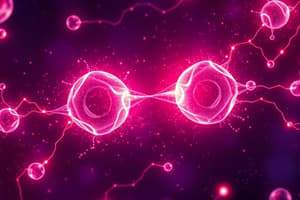Podcast
Questions and Answers
What is the nature of elements that commonly form ionic compounds?
What is the nature of elements that commonly form ionic compounds?
- Metals that lose electrons to become positively charged cations (correct)
- Non-metals that lose electrons to become positively charged cations
- Metals that gain electrons to become negatively charged anions
- Non-metals that gain electrons to become negatively charged anions
What happens to the formation of an ionic compound when elements with opposite charges interact?
What happens to the formation of an ionic compound when elements with opposite charges interact?
- They repel each other due to opposite charges
- They undergo a change in charge
- They form a stable compound (correct)
- They form a covalent bond
What characterizes the lattice structure of ionic compounds?
What characterizes the lattice structure of ionic compounds?
- Two-dimensional arrangement of ions held by weak forces
- Three-dimensional arrangement of ions held by strong electrostatic forces (correct)
- Linear arrangement of ions held by covalent bonds
- Random arrangement of ions held by weak forces
What determines the arrangement of ions in the lattice of an ionic compound?
What determines the arrangement of ions in the lattice of an ionic compound?
Which type of element gains electrons to become negatively charged anions in ionic bonding?
Which type of element gains electrons to become negatively charged anions in ionic bonding?
What property of ionic compounds makes them dissolve readily in polar solvents?
What property of ionic compounds makes them dissolve readily in polar solvents?
Why are ionic compounds not conductors of electricity in their solid state?
Why are ionic compounds not conductors of electricity in their solid state?
What is the role of electronegativity in the stability of an ionic compound?
What is the role of electronegativity in the stability of an ionic compound?
What factor plays a role in determining the stability of an ionic compound besides electronegativity?
What factor plays a role in determining the stability of an ionic compound besides electronegativity?
Why do ionic compounds have high melting and boiling points?
Why do ionic compounds have high melting and boiling points?
Flashcards are hidden until you start studying
Study Notes
Chemistry: A Deep Dive into Ionic Bonding
Ionic bonding, a critical concept in chemistry, helps us understand how elements with opposite charges connect to form chemical compounds. This article aims to provide a comprehensive overview of ionic bonding, its nature, and the formation of ionic compounds.
The Basics of Ionic Bonding
Ionic bonding occurs when elements with opposite charges (called ions) interact and form a stable compound. Elements that commonly form ionic compounds are metals, which lose electrons to become positively charged cations, and non-metals, which gain electrons to become negatively charged anions.
For example, consider the formation of sodium chloride (NaCl). Sodium (Na) is a metal and loses one electron to form a cation (Na+), while chlorine (Cl) is a non-metal and gains an electron to form an anion (Cl-). The electrostatic attraction between the oppositely-charged ions results in a stable ionic compound.
The Ionic Lattice
Ionic compounds are characterized by their lattice structures, which consist of repeating patterns of alternating cations and anions. This structure creates a stable, three-dimensional arrangement of ions that is held together by strong electrostatic forces.
The arrangement of ions in the lattice can vary depending on factors like the size of the ions, the charge magnitudes, and the coordination number (the number of nearest neighbor ions around a central ion). Common lattice structures include face-centered cubic (FCC), body-centered cubic (BCC), and primitive cubic (PC) structures.
The Ionic Compound's Properties
Ionic compounds possess distinct properties, such as:
- High melting and boiling points: The strong electrostatic forces between ions require a significant amount of energy to overcome, resulting in high melting and boiling points.
- Solubility in polar solvents: Ionic compounds dissolve readily in polar solvents like water because the polar solvent molecules can surround and separate the ions.
- Electrical conductivity: Ionic compounds are not conductors of electricity in their solid state, as the ions are held in a fixed lattice structure. However, they can conduct electricity when dissolved in a polar solvent or when molten.
- Brittleness: Ionic compounds are often hard and brittle because they are held together by the ionic lattice, which can be readily disrupted by mechanical stress.
Ionic Compound Formation and Stability
The stability of an ionic compound depends on the difference in electronegativity between the cation and anion, as well as the ionic charge magnitudes. Electronegativity is a measure of an atom's ability to attract electrons to itself, and the difference in electronegativity between the cation and anion should ideally be as large as possible for a stable ionic bond.
The ionic charge magnitudes also play a role in determining the stability of an ionic compound. If the charges on the cation and anion are too small, the electrostatic attraction between them may not be strong enough to create a stable compound. Conversely, if the charges are too large, the energy required to form the bonds may be prohibitively high.
Summary
Ionic bonding is a fundamental concept in chemistry, and it forms the basis for our understanding of how elements with opposite charges interact to form stable compounds. Ionic compounds have unique properties that set them apart from other types of compounds, and the factors that determine their stability include electronegativity, ionic charge magnitudes, and lattice structure. By studying ionic bonding and ionic compounds, we can better understand the underlying principles of chemistry and the world around us.
Studying That Suits You
Use AI to generate personalized quizzes and flashcards to suit your learning preferences.




